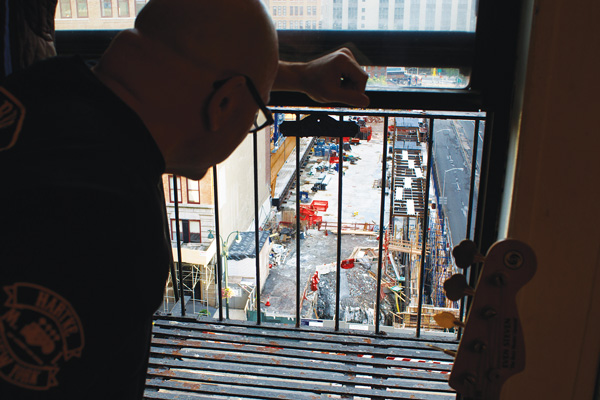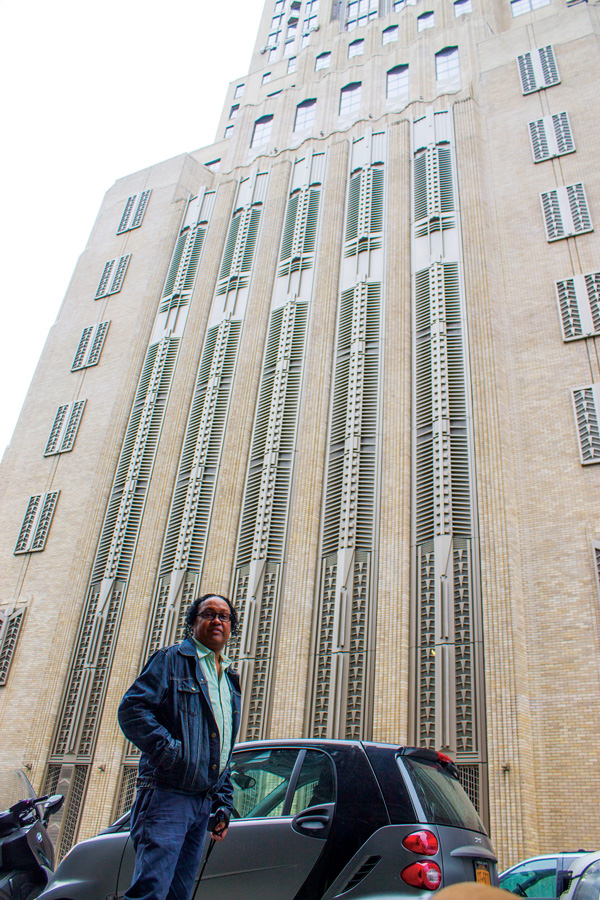
Noise allowed through After-Hours Variances put the damper on home recording last summer for 34th St. resident Even Steven Levee, a musician.
BY ZACH WILLIAMS | Lack of sleep was the high price paid by nearby residents — when the Department of Buildings (DOB) decided, on 122 dates, that after-hours work was in order for a $150 million condominium project to proceed with exceptional speed at the Walker Tower (210 W. 18th St., btw. Seventh & Eighth Aves.).
The conversion of the 32-story building into luxury living proceeded through the weekends of 2012 and 2013 under the auspices of After Hours Variances (AHV) — special permits issued by the DOB that allow construction work outside of normally acceptable hours. Between Jan. 1, 2012 and Dec. 31, 2014, the DOB issued AHVs to Manhattan developers 44,105 times, according to data made available through a Freedom of Information Law request filed in November on behalf of Chelsea Now.
For W. 18th St. resident Marcelo Sorino, AHVs enabled two years of weekend racket from across the street. One unit within the former Verizon headquarters sold for $50.9 million, according to The Wall Street Journal. Neighbors say they incurred a high cost to make it possible.
“It was absolutely terrible,” Sorino said in an interview. “Saturdays, Sundays, mornings, afternoons. The worst was taking all of the metal out of the building. They had the big, huge 40-foot dumpsters, they’d just throw the metal in there day and night.”
Public safety and emergencies are two situations when the City Administrative Code allows construction work beyond 7 a.m. to 6 p.m. on weekdays, or on weekends. Private developers can also claim undue financial hardship or that such work has a minimal amount of noise. Records indicate that 64 Manhattan developers met such criteria more than 100 times each between 2012-2014.

West 18th St. resident Marcelo Sorino worries that an addition atop Old Chelsea Station Post Office will cause after-hours disturbances similar to what he endured during construction of Walker Tower.
The most prolific AHV applicant in the borough was Thomas Gallagher, who received at least 965 AHVs, including 31 for five separate projects in the Community Board 4 (CB4) area. But he is only the 15th highest recipient in the community district, which spans the West Side from Chelsea to Hell’s Kitchen, according to the DOB. Michael Stern of JDS Development Group was the top applicant with 190 AHVs for work in the neighborhood — such as at the Walker Tower.
The 2013 completion of the condominium conversion at the W. 18th St. building cemented the emergence of Chelsea as a neighborhood of luxury housing. Another condominium development on the former property of the General Theological Seminary at 445 W. 20th St. exceeded Walker Tower for the highest amount (131) of AHVs issued for a CB4 construction project — while One Worldwide Plaza at 825 Eighth Ave. in Hell’s Kitchen was third with 107 AHVs.
Longtime residents such as Sorino — who has lived in the same W. 18th St. building for 20 years — recall a time when the West Side did not command so much attention for the well-to-do (such as actress Cameron Diaz, who bought a unit in the Walker Tower). The neighborhood was grittier in the past, but prolonged shuteye was easier to come by.
Work done under the auspices of an AHV now interrupts the daily lives of residents throughout the neighborhood, and not just through sleep deprivation. Collateral damage to quality of life also includes the loss of domestic amenities such as terraces and home work spaces rendered unusable due to the noise (as Chelsea Now reported in our July 17, 2014 edition). But complaining to the city via 311 yields little response for local residents. The DOB nullified 246 AHVs in 2013 — 22 times within CB4, according to the department. Totals for other years were not available at press time.
Like other neighborhood residents, Sorino saw little point in pursuing an administrative remedy to his sleepless nights. “I figured they’re putting a lot of money into it so what can I say?” he said.
The DOB asserts that AHVs are necessary in order to enable construction at schools, hospitals and other places where work during the day could endanger people or cause unreasonable disruptions on city streets. But more often than not, records indicate that intense work at high-end developments are the most common reasons for what are ostensibly exceptions to the rule.
Applicants claimed 2,002 times in 2012-2014 that after-hours work would involve relatively minor work to buildings in CB4. New building construction, major alterations, demolition and other work requiring new certificates of occupancy accounted for 2,072 out of a cumulative 4,074 AHVs issued during that period, according to the DOB.
That total represents the fourth-highest concentration of AHVs in the borough out of 12 community districts. Such a volume of after-hours work was within striking distance of CB6 (4,177) and CB1 (5,173) but was just over a quarter of the 15,728 AHVs issued for projects in neighboring CB5 — more than the combined amount of all such permits issued by the DOB in Brooklyn, Queens and Staten Island from 2012-2014, records indicate.
While the DOB application process for AHVs moves swiftly for applicants, a bill before the City Council which would apply new controls to them has made little progress since its introduction in early 2014.
The DOB issued 68,451 building permits in 2012 for projects in Manhattan. If spread equally across all taxable parcels in the borough, the total amount of AHVs from 2012-2014 would equal roughly 30 percent of all taxable properties. Despite a perception that this is too high of a volume, elected officials have signaled action on the issue mostly through words, without much of the fanfare accompanying top legislative priorities.
Councilmember Rosie Mendez — primary sponsor of the legislation with Dan Garodnick of the Upper East Side — said in a telephone interview on April 17 that the bill is still undergoing revisions in order to ensure that the right developers can still receive AHVs. The original text of the bill was “too broad” in terms of the restrictions it would impose, she said.
“The problem is with developers who get permit after permit after permit,” she said. But a council hearing on the legislation will not be possible until autumn at the earliest, she added.
City issuance of AHVs, meanwhile, will likely continue unimpeded. While Sorino spoke of the nights lost to the metallic clanging coming through his front window on W. 18th St., he pondered whether such interruptions might return in the near future courtesy of an eight-story tower slated to rise next door.
“Now my main concern is with the sale of the post office,” he said of the process underway to sell air rights for construction atop Old Chelsea Station Post Office.































